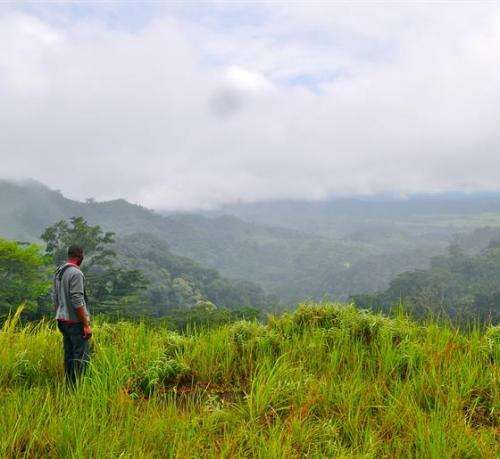Protected areas can safeguard global biodiversity and build peace in conflict hotspots

Today, the Conservation International (CI) Policy Center for Environment and Peace released five case study summaries that show that protected areas, through transparent and open agreements, can help to alleviate conflict while managing natural resources and conserving biodiversity in some of the most endangered places on Earth.
The case studies examine existing conflicts and describe the participatory processes necessary to reach consensus on resource use and ownership in parts of Bolivia, Ecuador, Democratic Republic of Congo, Liberia, and Timor-Leste. They highlight the importance of bringing together governments, civil society and local communities to take ownership of and manage natural resources, which can be a source of conflict.
"Conflict over natural resources has always been a thread in the conservation arena," said Kristen Walker Painemilla, managing director and senior vice president of CI's Policy Center. "The key to real and lasting international development and conservation is to address these underlying conflicts in many areas of the planet."
These successful examples of consensus-building and policy dialogue serve to inform policy and decision makers about the critical role conservation and sustainable development can have in peace-building. Well-managed parks and protected areas are essential to preserving the reservoirs of natural capital that provide people with essential ecosystem services like fresh water, clean air, food, climate regulation and disaster prevention.
"In a world with increasing population, dwindling wildlife habitat, greater competition for natural resources, and increasing unpredictability due to global climate change the need for environmental peacebuilding to create collaborative frameworks instead of competitive conflicts has never been greater, said J. Todd Walters, peace fellow at CI.
Walters adds, "Conservation International's case studies on Environmental Peacebuilding highlight examples of effective natural resource management despite the challenges of conflict, and creative ways to utilize cooperative conservation efforts to build peace amongst a diverse group of stakeholders at the community, national and international levels."
Also today, Janet Edmond, Senior Director for Peace and Development Partnerships at CI will present the Timor-Leste case study as part of a the IUCN World Parks Congress event on Conservation and Peacebuilding. During the event Wildlife Conservation Society (WCS) and IISD will also present conflict sensitive conservation techniques.
2014 IUCN World Parks Congress runs November 12 – November 19, 2014. It is a landmark global forum on protected areas. The Congress will share knowledge and innovation, setting the agenda for protected areas conservation for the decade to come. Building on the theme "Parks, people, planet: inspiring solutions", it will present, discuss and create original approaches for conservation and development, helping to address the gap in the conservation and sustainable development agenda.
COUNTRY CASE STUDY SUMMARIES
Liberia
In Liberia's East Nimba Nature Reserve, conflict emerged between local forest users and management authorities after the reserve was established without engaging communities. To resolve this multi-stakeholder dispute around rights to forest resources, CI is partnering with local organizations to implement a strategy using a Conservation Agreement model in which conservation investors provide a negotiated benefit package in return for conservation activities undertaken by communities. Following extensive community consultations, an agreement was reached by both parties securing ENNR as a strict nature reserve in return for compensation in the form of investments in improved health, education, infrastructure and livelihoods.
Bolivia
In Bolivia's Carrasco National Park, a longstanding conflict between protected area management and local populations was resolved when both parties agreed to a formal "red line" boundary between the protected area and land for use by the local communities. Points to mark the agreed upon boundary of the red line were determined with GPS navigators to ensure consensus, while the path was cleared and marked with red paint by community members themselves. The community now cleans and repaints the path on annual basis, accompanied by a park ranger.
The Democratic Republic of Congo (DRC)
In the Democratic Republic of Congo (DRC), an armed rebel group known as the Simba Mai Mai has taken up residence in one of the largest and most biodiverse parks in the country, Maiko National Park. The group is largely financed by illegal mining, which has devastated the local socioeconomic setting and contributed to an increase in violence and corruption. CI is coordinating with stakeholders in the area to prepare land use plans, which promote activities that strengthen the overall management of the land. True dialogue has been created to support nearby communities and engage the Simba in the process. One outcome has been the integration of ex-combatants as part of the park's management and ranger guard force.
Ecuador/Peru
The mountainous Cordillera del Condor region between Peru and Ecuador is an area that had long been contested, witnessing decades of periodic encroachment and active conflict. CI, working with government agencies and local scientists, carried out a Rapid Assessment in the region and confirmed its rich biological diversity and important role in maintaining the hydrological cycle that links the Andes mountain range to the Amazon. Independent, third-party science was used to negotiate the border's demarcation and a peace treaty was signed in which both countries committed to ending hostilities and opening up new avenues for collaboration.
Timor-Leste
In Timor-Leste's Nino Konis Santana National Park, CI is working with three conflict-affected communities to establish a co-management model for the park's abundant natural resources. The process for establishing co-management arrangements has proven an effective means of reducing conflict and fostering collaboration across stakeholders. For example, recognizing that traditional natural resource management practices in Timor-Leste often silence women's perspectives from the decision-making process, we are helping to incorporate a decision support tool to ensure those processes are more inclusive of women's voices.
More information: To see the case studies in full, please visit sites.google.com/a/conservatio … g/peace/case-studies
Provided by Conservation International




















